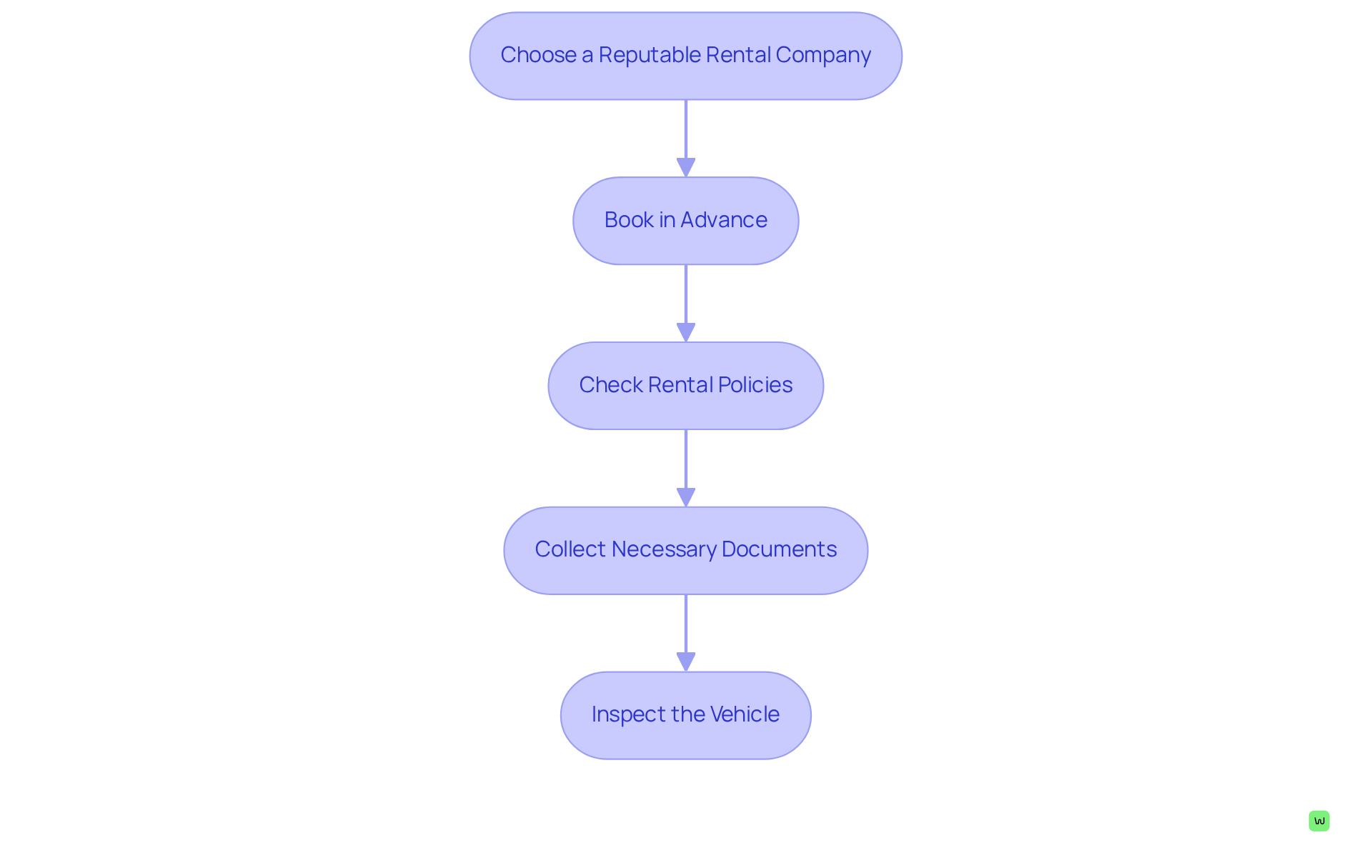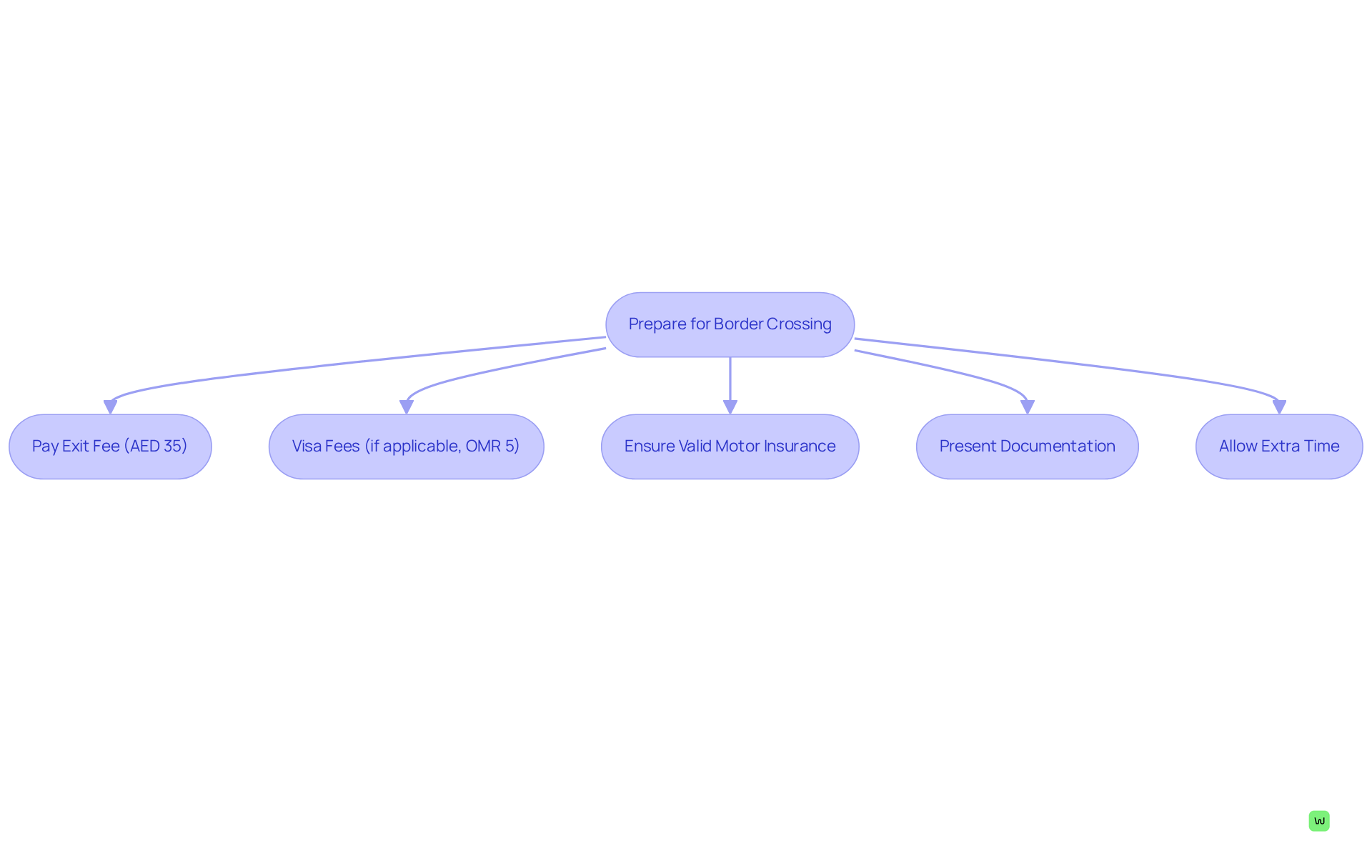Overview
Traveling from Oman to Dubai requires meticulous preparation to ensure a seamless experience. Key elements include:
- Essential Travel Documents: Ensure you have your passport and visa ready.
- Route Selection: Choose from various scenic and efficient routes for your journey.
- Car Rental Arrangements: Understand the steps involved in renting a car.
- Border Crossing Fees: Familiarize yourself with the fees associated with crossing the border.
By addressing these components, travelers can navigate the journey smoothly, ensuring they are well-informed and ready for a hassle-free adventure.
Introduction
Traveling from Oman to Dubai presents a unique blend of cultural experiences and stunning landscapes, making it a journey that many find appealing. This guide outlines four essential steps to ensure a seamless transition across borders, from preparing necessary travel documents to selecting the best route.
- Prepare necessary travel documents
- Understand visa requirements
- Be aware of border crossing fees
- Select the best route
With varying visa requirements and border crossing fees, how can travelers navigate these complexities effectively? This question invites you to explore strategies for a stress-free adventure.
Prepare Necessary Travel Documents and Visas
Before embarking on your journey from Oman to Dubai, ensure you possess the following essential documents:
- Passport: Your passport must be valid for at least six months from your date of travel.
- Visa: Depending on your nationality, a visa may be required for entry into Dubai. Citizens of GCC countries, including those traveling from Oman to Dubai, typically do not need a visa. However, it is crucial to verify the latest regulations.
- Emirates ID: If you are a UAE resident, ensure you have your Emirates ID.
- Travel Insurance: While not mandatory, having travel insurance can provide peace of mind during your trip.
- Vehicle Documents: If you plan to drive, ensure that your vehicle registration and insurance documents are readily available.
Make sure to keep these documents easily accessible throughout your journey to facilitate a smooth crossing process.

Choose Your Preferred Route to Dubai
When traveling from Oman to Dubai, you have several route options tailored to different preferences:
-
Hatta Border Crossing: This route is the most favored, celebrated for its breathtaking drive through the Hatta mountains. The journey typically takes about 4-5 hours, making it an excellent choice for those who appreciate stunning landscapes. It’s important to note that it takes approximately an hour and 20 minutes to reach the Hatta-Al Wajajah border from the city.
-
Al Wajajah Border Crossing: Another popular option, this well-maintained crossing offers a direct and efficient path for travelers moving from Oman to Dubai, ideal for those seeking a quicker transit. Ensure that your vehicle possesses an Orange Card, which is required for all vehicles journeying between the UAE and its neighboring country.
-
Coastal Route: For those who enjoy picturesque views, the coastal route via Fujairah is highly recommended. This scenic path showcases stunning views of the Gulf, although it may extend your travel time.
Additionally, be aware of the visa requirements for entry into the country, with fees starting from five Omani rials (approximately Dh50).
Select a route that best fits your travel style—whether you prioritize a swift arrival or wish to indulge in the scenic beauty along the way.

Arrange Car Rental for a Smooth Journey
To ensure a smooth journey from Oman to Dubai, follow these essential steps for arranging your car rental:
- Choose a Reputable Rental Company: Select a company renowned for its luxury vehicles, such as WheelsOn, which specializes in high-end rentals in Dubai. This choice guarantees a premium experience.
- Book in Advance: Secure your preferred vehicle by making your reservation online well ahead of your departure date. This not only guarantees availability but also helps you avoid last-minute complications. Industry experts recommend booking at least two weeks in advance to ensure the best selection and pricing.
- Check Rental Policies: Confirm that the rental company allows cross-border movement to the Sultanate. Familiarize yourself with any additional fees or insurance requirements that may apply to your rental agreement, as this can vary significantly between companies.
- Collect Necessary Documents: Prepare your driving license, passport, and any other required documentation to streamline the vehicle pick-up process.
- Inspect the Vehicle: Before driving off, thoroughly inspect the car for any pre-existing damage and ensure it meets your expectations for luxury and comfort. This step is crucial for a hassle-free experience, aligning with WheelsOn's commitment to transparency and customer satisfaction.
By adhering to these steps, you can appreciate a smooth and delightful travel experience when planning your journey from Oman to Dubai, maximizing your trip between the two locations.

Understand Border Crossing Requirements and Fees
When crossing the border from Oman to Dubai, it is essential to be prepared for the following requirements and fees:
- Exit Fee: A fee of AED 35 is payable at the UAE border when leaving the country.
- Visa Fees: If applicable, a visa on arrival for the country costs approximately OMR 5 (around AED 47).
- Insurance: Ensure you have valid motor insurance that covers you in Oman. If your rental agency does not offer this, you may need to purchase it at the crossing.
- Documentation Check: Be ready to present your passport, vehicle registration, and insurance papers at the crossing.
- Time Considerations: Allow additional time for crossing procedures, particularly during peak travel periods or holidays.
By understanding these requirements, you can navigate the border crossing smoothly and enhance your journey from Oman to Dubai.

Conclusion
Traveling from Oman to Dubai can be a seamless experience when the right preparations are made. Understanding the necessary travel documents, selecting the ideal route, arranging car rentals, and being aware of border crossing requirements are crucial steps that ensure a smooth journey. By taking these considerations into account, travelers can enhance their overall experience and focus on enjoying the adventure ahead.
This guide has highlighted key aspects such as:
- The importance of having valid passports, visas, and vehicle documents.
- The benefits of choosing the right route based on personal preferences.
- Booking car rentals in advance.
- Understanding the fees associated with border crossings.
Each of these elements plays a vital role in avoiding unnecessary delays and complications during the trip.
Ultimately, being well-informed and prepared can transform the journey from Oman to Dubai into a memorable experience. Whether it's savoring scenic views along the coastal route or ensuring all documents are in order for a hassle-free border crossing, every detail matters. Embrace the opportunity to explore the vibrant culture and attractions that await in Dubai, and make the most of this exciting travel adventure.
Frequently Asked Questions
What travel documents are required to travel from Oman to Dubai?
You will need a valid passport, which must be valid for at least six months from your date of travel, and possibly a visa depending on your nationality. Citizens of GCC countries typically do not need a visa.
Do I need a visa to enter Dubai from Oman?
It depends on your nationality. Citizens of GCC countries, including Oman, usually do not need a visa, but it's important to verify the latest regulations before traveling.
What should UAE residents carry when traveling to Dubai?
UAE residents should carry their Emirates ID along with their passport.
Is travel insurance necessary for traveling from Oman to Dubai?
Travel insurance is not mandatory, but it is recommended as it can provide peace of mind during your trip.
What documents do I need if I plan to drive in Dubai?
If you plan to drive, ensure that you have your vehicle registration and insurance documents readily available.
How should I manage my travel documents during the journey?
It is advisable to keep all necessary documents easily accessible throughout your journey to facilitate a smooth crossing process.




